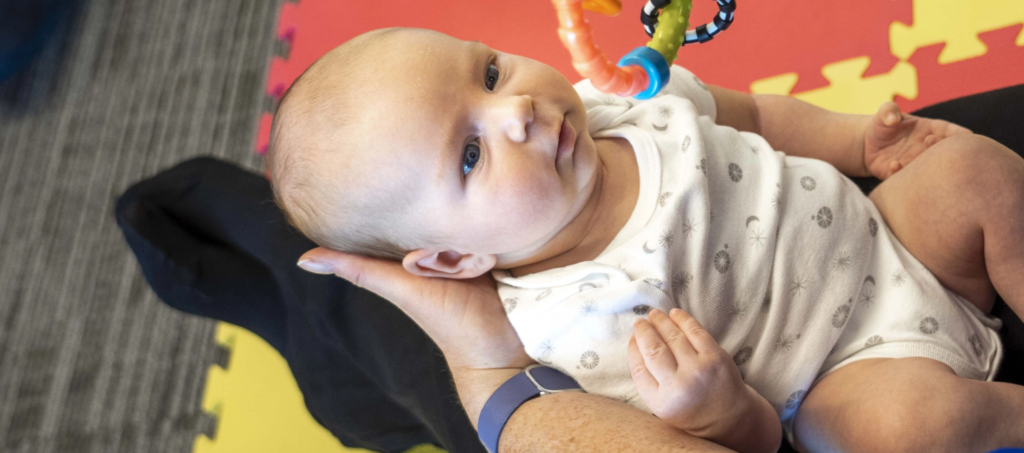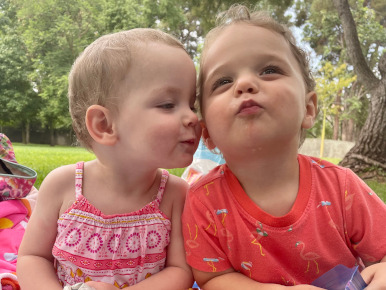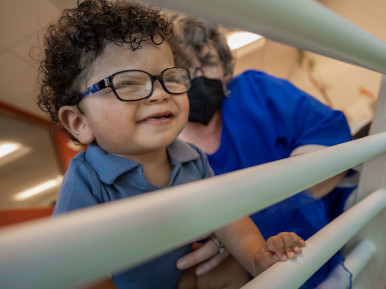PROVIDERS
PROVIDERS
Sharing is caring
Providers are healthcare professionals with specialized training and expertise in diagnosing and treating medical and developmental conditions. They include doctors, therapists, psychologists, case workers, and other professionals who work directly with children and their families. Providers involved in the early diagnosis of cerebral palsy often work in interdisciplinary (multiple providers with different expertise) clinics or practice. The expertise of multiple providers and perspectives can ensure confidence in the diagnosis and allow for the providers to share more insights about the child early in the first year of life.

ROLES AND
RESPONSIBILITIES
Within our medical and educational systems different providers are expected to play different roles in the care of children. However, the specific training of an individual provider may allow for some variation for the role described below. In some cases, there is overlap between what some providers’ roles are in early diagnosis and treatment of CP. Click below to expand each section and explore the different roles and responsibilities involved for each type of individual.
Families
Caregiver and Patient Advocate
- Parents and other caregivers are an essential part of the team when assessing an infant or child with a developmental delay or disability. The child’s legal guardian has the right to approve any assessment or treatment.
- (Download our table with the full list of the expected responsibilities involved in this role)
Hospital
NICU Team
- Made up of physicians, nursing, and other providers, this team is responsible for preparing the parent to care for a child at home. These providers are responsible for completing assessments and acting on the findings to support the child’s development during the transition to home.
- (Download our table with the full list of the expected responsibilities involved in this role)
Pediatricians
Primary Care Physicians or Nurse Practitioners
- A child’s primary care physician has a unique relationship with the child and parents over many years. However during the first year of life they play a crucial role in identifying developmental problems. These clinicians provide direct medical care of the infant and refer as needed to other clinicians with expertise in the care of infants with special health needs.
- (Download our table with the full list of the expected responsibilities involved in this role)
HRIF
High Risk Infant (HRIF) Follow-up
- High-risk infant follow up programs are designed to evaluate the medical and developmental needs of children who were born early or have a rough start requiring care in the NICU.
- (Download our table with the full list of the expected responsibilities involved in this role)
Regional Center
Regional Center (RC): Intake coordinator, therapists, and others
- Each Regional Center is a private, non-profit case management agency under contract with the California Department of Developmental Services (DDS) that contracts with service providers to provide direct services to individuals with developmental disabilities in California regardless of citizenship and legal status. Developmental Disabilities include intellectual disability, CP, epilepsy, autism, and other disabilities closely related to intellectual disability. RC provides early intervention services to 0-3 year-old children identified with at least a 25% delay in any 1 area of the 5 developmental domains (Cognitive, Physical, Communication, Social/emotional, Self-help/Adaptive) Ref: Codes Display Text (ca.gov)
- (Download our table with the full list of the expected responsibilities involved in this role)
CCS: General
California Children’s Services (CCS): General Program:
- CCS is a state program mandated to provide medically necessary, program eligible, services for kids with CP. They authorize and track High Risk Infant Follow-up services for those meeting criteria. Ref: Download DHCS Guidelines
- (Download our table with the full list of the expected responsibilities involved in this role)
CCS: Therapy
CCS: Medical Therapy Program
- A state program mandated to provide medically necessary OT and PT for eligible conditions (e.g. CP). Consists of an interdisciplinary team of physicians, OTs, PTs, nurses, and social workers.
- (Download our table with the full list of the expected responsibilities involved in this role)
Outpatient
General Pediatric Therapists
- Outpatient pediatric physical or occupational therapists or speech language pathologists who provide evaluation and short-term intervention for rapid start of therapy, following medical changes, or an episode of care. They may also provide therapeutic services for children who may not be CCS eligible; communicate with service coordinators, families, and other therapists
- (Download our table with the full list of the expected responsibilities involved in this role)
Centers & Groups
Family Resource Center Network & Other Family Advocacy Groups
- Parent-to-parent support via a network of 45 Family Resource Centers (FRCs) for families of children birth – 3 years of age and beyond. The funding is part of the Early Start Program through the California Department of Developmental Services and is required through Part C of the Individuals with Disabilities Education Act (IDEA). Reference Link
- (Download our table with the full list of the expected responsibilities involved in this role)
Medi-Cal
Medi-Cal Managed Care Plans
- State and federal program mandated to authorize and pay for medically necessary services for eligible beneficiaries. They are also required to refer potentially eligible beneficiaries to California Children’s Services. Ref: Medi-Cal All Plan Letter 18-011 All Plan Letter 18-011
- (Download our table with the full list of the expected responsibilities involved in this role)
TRAINING IN EARLY DETECTION OF CP
In order to implement the international guidelines for the early detection of CP in hospitals and clinics around LA county, we need to have enough trained practitioners to administer neccesary gold standard developmental assessments.
- Hammersmith Infant Neurological Exam (HINE)
- HINE is the ideal neurological exam to use in the early detection of cerebral palsy. It is scorable allowing for use in research and practice with infants 2 to 24 months of age. Training is widely available for certified trainers throughout the world.
- REF: Use of the Hammersmith Infant Neurological Examination in infants with cerebral palsy: a critical review of the literature. DMCN 2016 58(3) p 240.
Reference Link
- HINE is the ideal neurological exam to use in the early detection of cerebral palsy. It is scorable allowing for use in research and practice with infants 2 to 24 months of age. Training is widely available for certified trainers throughout the world.
- Hammersmith Neonatal Neurological Exam
- HNNE is a neurological exam designed for neonates and infants through 2 months of age. It is used in research and some clinical practice. Training is often available through the same groups that provide HINE training.
- Ref: Huf, I.U., Baque, E., Colditz, P.B. et al. Neurological examination at 32 weeks postmenstrual age predicts 12-month cognitive outcomes in very preterm-born infants. Pediatr Res 93, 1721–1727 (2023).
Reference Link
- HNNE is a neurological exam designed for neonates and infants through 2 months of age. It is used in research and some clinical practice. Training is often available through the same groups that provide HINE training.
- General Movement Assessment:
- The Precthl General Movement assessment has shown its merit for the prenatal and postnatal evaluation of the integrity of the nervous system. Compelling evidence is available that the assessment of General Movements (GMs) at a very early age is the best predictor for cerebral palsy. This method has become a potent supplement to the traditional kind of neurological examination.
- ref: The Predictive Accuracy of the General Movement Assessment for Cerebral Palsy: A Prospective, Observational Study of High-Risk Infants in a Clinical Follow-Up Setting. J Clin Med. 2019 Oct 25;8(11):1790. doi: 10.3390/jcm8111790. PMID: 31717717; PMCID: PMC6912231.
Reference Link - Sign up for training at General Movements Trust.
- The Precthl General Movement assessment has shown its merit for the prenatal and postnatal evaluation of the integrity of the nervous system. Compelling evidence is available that the assessment of General Movements (GMs) at a very early age is the best predictor for cerebral palsy. This method has become a potent supplement to the traditional kind of neurological examination.
- Test of Infant Motor Performance (TIMP):
- The TIMP is a test of functional motor behavior in infants for use by physical therapists, occupational therapists, and other health professionals in special care nurseries and early intervention or diagnostic follow-up settings. Assessing the postural and selective control of movement needed for functional motor performance in early infancy.
- Ref: The Test of Infant Motor Performance at 3 months predicts language, cognitive, and motor outcomes in infants born preterm at 2 years of age.
Reference Link - Sign up for training at Infant Motor Performance
- The TIMP is a test of functional motor behavior in infants for use by physical therapists, occupational therapists, and other health professionals in special care nurseries and early intervention or diagnostic follow-up settings. Assessing the postural and selective control of movement needed for functional motor performance in early infancy.

EARLY DETECTION
GUIDELINES OF CP IMPLEMENTATION
Are you interested in implementing best practices in your hospital or clinic for early identification and intervention for infants at risk for CP? Use the tools below to get started and contact Ei3 for help if you encounter roadblocks.
- Discharge Summary – Included information in the discharge summary about a child’s risk factors, motor assessment, neurological exams or neuroimaging findings can speed up access to services. Try using or adapting our discharge summary template to learn what fields are needed to streamline eligibility determination for necessary state and local services.
Discharge summary (PDF) - Sample of Implemented Clinic Workflow
- CP Alliance resources for providers on how a clinic could be structured to support early diagnosis of CP.



